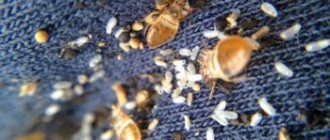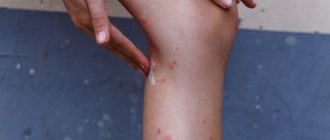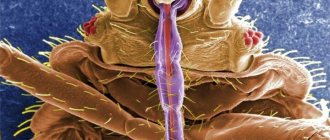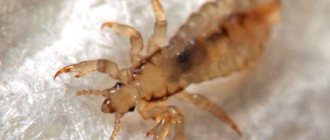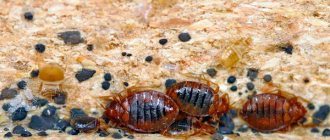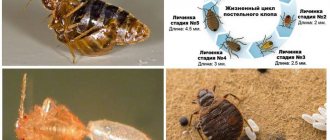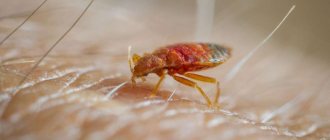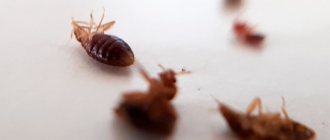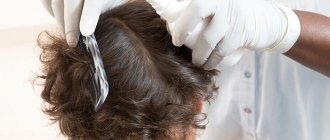The appearance of bedbugs in the house can be noticed by the characteristic bites that appear on the skin after sleep. Such a neighborhood is not a pleasant one: blood-sucking parasites continually cause new damage, disturbing the peace of the owners - this, in turn, can soon lead to insomnia and a nervous breakdown.
But bedbugs, like other insects, also have their own weaknesses, which are simply necessary to know in the fight against parasites. For example, many people are interested in whether bedbugs are afraid of light, and what will happen if you don’t turn off the lights all night. This article provides the answer to these questions.
Are bedbugs afraid of light?
It is believed that bedbugs are repelled by light. Indeed, if you wake up at night and turn on the lamp, insects try to hide behind something. This is why people think that leaving a light on all night will stop them from biting. They leave the lamp on for 1, 2, 3 days - no new bites appear. But then the bugs crawl out of their hiding places and attack with renewed vigor.
Constantly switched on light changes the habitual way of life of parasites. They are used to being active in the dark, so they wait for its onset for several days. All this time they remain hungry. When hunger becomes too severe, they have to leave their shelters to avoid dying. The result is complete adaptation of insects to light. Therefore, it is effective against them only for a short time.
Removing bedbugs using an ultraviolet lamp
Ultraviolet and quartz lamps are used in medicine to disinfect premises. They emit ultraviolet light in the frequency range that is capable of resolving the DNA of microorganisms. Such radiation is also harmful to humans. It causes dry skin and leads to premature aging. High-intensity light can cause retinal burns.
If ultraviolet radiation is harmful even to humans, are bedbugs afraid of ultraviolet lamps? Yes, their eyes are very sensitive to light, which can blind them. But vision is secondary for parasites. They spend most of their time in the dark and navigate only by smell. Therefore, briefly turning on an ultraviolet or quartz lamp will not bring the desired effect.
In order for ultraviolet light to kill a bug, it must be exposed to light for 4–5 days. Then the light will cause dehydration and death of the insect. You can’t keep the lamp on for that long at home. A person will receive more harm from it than from the bite of a bed parasite.
Powder that bedbugs are afraid of
ECOKILLER is a natural insecticide based on diatomite. It is sold in bottles with a long and narrow dispenser tube. With its help, you can pour the powder into all places where bedbugs can hide: behind the baseboard, sofa, bed mattress and small crevices. After a day, the house needs to be wet cleaned. If parasites are detected, the procedure is repeated.
How does Ecokiller work?
Here are the advantages of ECOKILLER:
- The product has no odor.
- Diatomite is not addictive to insects.
- The powder is safe for humans and animals. It is often used to produce dietary supplements and vitamin-mineral complexes.
- The product is used sparingly. For processing an apartment of 50 square meters. one bottle of 500 ml is enough. You can order it here.
The fight against bedbugs requires urgent measures. Parasites can be removed using different methods. But those products that harm bedbugs are also dangerous for humans. Therefore, they cannot be used in a home with children. In this case, it is better to use an alternative and no less effective method, which is to treat the home with diatomaceous earth powder. After contact with it, bedbugs will die within 7–9 days.
- Ecokiller bed bug repellent 150 ml.
₽ 149,00
- Ecokiller for bed bugs 500ml.
₽ 349,00
Does bleach kill insects?
Bleach is not an effective insect control agent. The powder is scattered around the perimeter of the apartment, but there is no guarantee that harmful insects will crawl into these places. But it will not be possible to treat every parasite manually.
Bleach burns through the bug's shell, which causes its death.
In addition, the pungent smell of chlorine repels insects, and they try to crawl away from places where lime is scattered. However, they continue to stay in the house.
In some cases, when using this substance, parasites may temporarily reduce their activity. But chlorine tends to quickly evaporate, after which the bedbugs return to their places.
Since insects try to hide after detecting an unpleasant odor, the effect of bleach on them will be insignificant, while the substance can cause severe poisoning in humans. Therefore, it is not recommended to treat the entire house with this product. It is better to limit yourself to individual small areas.
Chlorine-based insecticides are produced that are more effective than the substance in its pure form.
Do smells repel bedbugs?
Couch bloodsuckers have a developed sense of smell. They smell a person at a distance of up to 3 meters, and carbon dioxide released during breathing - at a distance of up to 30 m. Therefore, it is believed that treating the home with strong-smelling compounds helps repel bedbugs. Is it so?
Vinegar
Vinegar has a pungent odor. Therefore, it can act as a repellent, but not longer than 6 hours. It should be borne in mind that acetic acid is often diluted with water before use to obtain a solution with a weak concentration. In this form, it will not be able to spoil the furniture and decoration. But then the smell will disappear in half an hour.
To get the desired effect, you will have to treat the apartment with vinegar essence. But concentrated acid not only damages property, its fumes cause burns to the mucous membranes of the eyes and respiratory tract. Therefore, using vinegar against bedbugs is either useless or dangerous.
Tar
It is a resinous product that is obtained by dry distillation of wood. It contains resins, phenol, toluene, cresol, benzene, toluene and other substances. They have a strong odor that penetrates into materials. It is impossible to remove it later, but it can take months to disappear on its own.
Despite the strong smell, tar does not work any better than vinegar. During the first days, parasites can remain in shelters. But when hunger becomes stronger than fear, they will still crawl out and get your blood. But your apartment will smell for a long time.
Bleaching
Bleach is used to bleach fabrics and disinfect premises. It smells strongly and causes a burn upon contact with the outer shells. That's why bedbugs are afraid of her. To remove them from the apartment, you need to wash the floors and other surfaces with water and bleach. To prevent burns, you should work with gloves.
You can also use bleach to control bedbugs. It needs to be scattered in all corners, crevices, and secluded places. It will disrupt the integrity of the bug's shell and lead to the death of the parasite. The price of such a victory is the unbearable smell of chlorine, which can cause poisoning and pulmonary edema.
Attention! Bed bugs are afraid of bleach. But it cannot be used in large quantities at home, because it is no less toxic to humans than to insects.
Flammable substances
If bed bugs appear in a house, people advise treating it with gasoline, diesel fuel or kerosene. The point here is not so much the smell, but the resinous consistency of the liquid fuel. It clogs the sensilla - the respiratory organs on the surface of the bug's body, through which oxygen enters (insects do not have a nose). As a result, the parasites suffocate.
To get rid of bedbugs using gasoline, kerosene or diesel fuel, you need to thoroughly treat all surfaces and crevices in which bloodsuckers can hide. Then they will inevitably touch the fuel while leaving the shelters. The problem is that flammable vapors are highly toxic to humans. Another danger lies in creating a fire hazard - the house can burst into flames from the slightest spark.
Essential oils
It is believed that the use of essential oil is effective against bedbugs. Presumably they are afraid of essential oil:
- nettle;
- rosemary;
- chamomile;
- carnations;
- lavender;
- peppermint;
- tea tree.
Using essential oils in their pure form is dangerous for humans and is ineffective in the fight against bedbugs. In order for them to smell the smell, you need to force the ether to actively evaporate. This can be done by diluting a few drops of oil in vodka. The alcohol contained in it is highly volatile and promotes better evaporation of substances dissolved in it.
You can make your own repellent using essential oils. This is the name of the odorous product that bed bugs are afraid of. To prepare it you will need:
- 60 ml water;
- 30 ml vodka;
- 10 drops of peppermint and lemon (grapefruit) essential oil;
- 8 drops of lavender essential oil;
- 5 drops of geranium oil;
- 3 drops of rosemary, cypress and vanilla oils (can be replaced with patchouli and myrtle oils).
All components must be mixed until smooth and placed in a spray bottle. Homemade repellent should be used daily on living rooms and furniture. The advantages of this product are safety for humans and a pleasant aroma at home. The disadvantages include the low efficiency of the method. Over time, bedbugs will get used to the smell, and it will no longer repel pests.
Attention! Many essential oils are contained in the peel of citrus fruits. You can place them under the sofa, behind the bed, near cracks and other hiding places.
Plants with a pungent odor
Scented plants act like essential oils. Bed bugs do not like the pungent smell of plants such as:
- tansy;
- sagebrush;
- marigold;
- chamomile;
- calamus (root);
- mustard (seeds).
There are several ways to use herbs in the fight against bedbugs. You can lay out sprigs of tansy or wormwood on the floor, put them in a closet with linen, or tuck them into the folds of upholstered furniture. But when they dry, the aroma from them will decrease. It is difficult to pull out branches intact from secluded places - they become fragile, causing them to break and leave behind debris.
Another way to use herbs against house bugs is to prepare decoctions. For 1 liter of water you will need 20–30 g of dry grass, inflorescences, roots or seeds. They are placed in a pan and filled with water, placed on the stove. The herb and inflorescences should be boiled over low heat for 5 minutes, seeds - 10 minutes, roots - at least 20 minutes. Then the broth is cooled, filtered and used as a repellent.
Preparing a repellent based on herbal decoction takes a lot of time. But the method is not highly effective. Another disadvantage is that herbal infusions leave stains that are difficult to wash off on fabrics.
Seasonings
It is popularly believed that bedbugs do not like the smell of bay leaves, vanillin, rosemary and cloves. We have already concluded above that “aromatherapy” in the fight against bedbugs is ineffective, and it gives only temporary results. Therefore, seasonings should be used only in combination with other, more effective methods. They can be placed around the house in whole branches or sprayed with the prepared decoction.
Solvents
Acetone and turpentine also have a strong odor. However, bed bugs are afraid not of the smell of solvents, but of contact with them. They corrode the shells of insects, which leads to their rapid death. Despite the ability to exterminate parasites, the use of acetone and turpentine at home is undesirable because:
- solvents are toxic to humans;
- they dissolve paintwork;
- spoil fabrics and other materials;
- They leave behind a persistent unpleasant odor that does not disappear for a long time.
Tar or laundry soap
You can try to repel bedbugs with a soapy smell. Laundry or tar soap are more suitable for this purpose. They leave lingering odors even after drying. For humans they are harmless and quite tolerable. Another advantage of the method is that the soap film that envelops the bug interferes with its breathing. This can lead to the death of insects. But in order to treat parasites with a soap solution, you will first have to find their nesting sites.
Medicines
Among the medicines used in the fight against bedbugs, ammonia and Vietnamese balm “Zvezdochka” are used. Ammonia quickly dissipates, but the balm not only has a persistent odor, but also irritates the body of the bug upon contact. After all, it represents a high concentration of essential oils. But for processing at home you will need as much balm as you will not find in any pharmacy.
A solution of boric acid is also sometimes used in fighting. It doesn't actually harm bedbugs. They are not afraid even of its smell. The product is mistakenly used against bed bugs because it is effective against cockroaches. But the latter die from ingesting acid, while bedbugs feed only on blood.
Folk remedies
The most popular and often used in practice answer to the question of what bedbugs do not like and are afraid of concerns still popular folk remedies. They can also be divided into several groups, the main ones being these.
- Scented herbs. These include: wormwood, wild rosemary, tansy, chamomile, calamus and many other plants with a strong odor. Both fresh and dried herbs are used to repel bedbugs, but the former usually smells stronger, and therefore its use is more effective. It is allowed to prepare infusions and other liquid products based on plants. It is important to remember that it is not only bedbugs that dislike strong odors. Direct contact with plant materials can cause an allergic reaction in humans, and exposure to the smell can cause dizziness or shortness of breath. Therefore, the practical use of this folk remedy requires caution and accuracy.
- Essential oils. The principle of their action on bedbugs is similar to odorous herbs and is based on a pungent odor. The source of essential oil, which insects are very afraid of and do not like, can be both various plants (lavender, eucalyptus, rosemary and others) and perfume products, for example, cologne. What was said above about safety for humans is completely true in this case, as well as for any practical use of substances or objects with a strong and pungent odor.
- Kerosene, turpentine, vinegar and other similar preparations. All of the above and many other strong-smelling substances are very unpleasant to bedbugs - they do not like them and are afraid of them. The choice of a specific drug to repel or destroy parasites depends on the capabilities of the person and the availability of a particular drug. The main thing to remember when fighting bed bugs is caution and accuracy to prevent harm to the residents of the apartment or house. Otherwise, you need to use any of the numerous thematic Internet resources devoted to this topic to prepare a solution for treating a room infested with bedbugs.
- Corrugated cardboard. A simple, affordable and practically free way to combat bedbugs. Provides for laying out pieces of corrugated cardboard in places where parasites live. Bedbugs love and are not afraid to use the material as shelter during daylight hours. That’s why they crawl inside in large numbers. The owner of an apartment or house can only collect the cardboard and destroy the insects, for example, through simple burning. Naturally, new pieces of cardboard are laid out in their original place. It will not be possible to exterminate the entire population of bed bugs in an apartment or house in this way. But the number of parasites can be greatly reduced in just a few days.
The folk remedies described above can hardly be called the most effective and efficient. But they continue to be widely used in practice due to their availability and minimal associated costs. Moreover, when used correctly, a certain effect can almost always be achieved, since bedbugs really do not like and are very afraid of odorous plants and preparations.
On the effectiveness of electronic repellers
In recent years, electronic repellers against all pests have gained wide popularity. They are really effective against rodents, moles, birds and even mosquitoes. But in the case of bedbugs, the devices are useless. Bed bloodsuckers are not afraid of ultrasound, electromagnetic or other radiation, because they do not have sensory organs capable of perceiving it.
Bedbug bites in children
Bedbug bites in children do not look too serious: slight redness and blisters dissolve quite quickly, the main thing is not to let the skin be scratched to avoid infection. The itching goes away and the child does not feel any serious discomfort. If the baby’s body is too susceptible, complications arise in the form of:
- lymph nodes become inflamed;
- an allergic reaction flares up;
- temperature rises;
- headache appears;
- digestion is upset;
- Infection of damaged skin occurs.
These symptoms appear quite rarely. The main discomfort is psychological. Bite-bitten children do not have the opportunity to sleep soundly and normally; this makes them capricious and nervous, which affects the morale of not only the children, but also the parents.
Is it possible to drive away bedbugs by starving them?
Bedbugs need food 2 to 7 times a week. Therefore, some people think that leaving home for 1–2 weeks is enough for the insects to die of starvation. This raises the question: are bedbugs afraid of the lack of a nearby food source?
If the search for food is unsuccessful, the insects fall into torpor. They can live in this state for several months. If, having “awakened” they do not get blood again, death is assured. But how many families are willing to leave home for many months?
What does a bug bite look like?
If there are parasites in the house, bite marks cannot be ignored. Waking up in the morning, you can see red spots and numerous spots on the body, which over time become inflamed and begin to itch very much. Typically marks can be seen on the back, shoulders and neck. After some time, the redness goes away and the itching stops, but there are cases of individual intolerance and allergies.
There are a number of signs by which bedbug bites are identified:
- The consequences of bites are accompanied by a slight swelling with redness of the skin around and a protruding central part.
- If you carefully examine the center of the puncture, you can see a small hole that the bug made with its proboscis.
- Bed bugs rarely bite once. After the attack, a trail remains in the form of tracks at intervals of two to four centimeters. Tracks can start with single points and end with dozens.
- After the bug leaves the bite site, blood continues to seep from under the skin for some time, so small bloody spots remain on the bed linen.
- While sucking blood, the insect injects a specific substance under the human skin, which muffles pain and only after a while the wounds swell and begin to itch.
- Bedbugs come out to hunt only at night; during the daytime they scatter in different corners. Only irresistible hunger can force them to leave the shelter during the day.
- There is a strong burning sensation and a feeling of mild pain at the bite sites. These areas of the body become very itchy and begin to peel off.
The body's reaction depends entirely on the puncture site and the thickness of the skin. The skin on the neck and face is delicate; in these places, bites manifest themselves as more severe redness and swelling and serious pain. An allergic reaction of the body is possible, in which case you need to take an antihistamine.
Differences between bedbug bites and bites of other parasites
Each blood-sucking species has its own specific “style” of bite, traces of which remain on human skin. The methods of sucking blood by bedbugs differ from the bites of other insects.
Mosquitoes
When a person wakes up in the morning and sees inflamed spots on the body, there are assumptions that these are mosquito marks. At first glance, the bite left by a bug resembles a mosquito bite. But subsequently, the number of lesions on the skin, the smooth inflamed path and the bitten places inaccessible to the mosquito, are puzzling, because they were covered with a blanket all night.
The mosquito is not able to get under the blanket and night clothes. In addition, during the cold season there are no mosquitoes.
Fleas
Skin lesions left by fleas can actually be mistaken for a bedbug attack. But there are certain places on the human body that fleas bite most often - armpits, popliteal cavities, waist. These preferences differ from bedbugs. Visually, the mark of a bug bite is difficult to distinguish from a flea bite.
Midges
Midges operate in the summer and bite mainly on the street. The midge attacks open areas of the body, flies into the hair and bites into the scalp. Unlike midges, bedbugs do not bite a person's face. And the moment of a midge bite itself is much more painful, since it does not contain an anesthetic secretion.
Are bedbugs afraid of pesticides?
Yes, bed bugs are very afraid of pesticides. But they do not cause fear in them, so they do not have repellent properties. However, upon contact with the insect's body, drugs called insecticides lead to their destruction. Here are the means that can be used to treat residential premises:
- aerosols (Dichlorvos, Combat);
- suspensions (Xulate Micro, Get Total);
- liquid chemistry (Executioner, Karbafos).
The advantage of using insecticides is the high efficiency of treatment. But it must be carried out twice with an interval of 10 days in order to destroy the larvae that have hatched from the eggs by this time, but have not yet reached puberty. Another disadvantage of the chemical is that over time, bedbugs develop resistance to it. Its development can be eliminated only by major treatment of premises, which is carried out by specialized organizations using the hot fog method.
Attention! Insecticides are toxic to humans and animals. Therefore, after using them, you need to leave the apartment with your pets for several hours.
How to use
People without professional training can use bleach only for the purpose of repelling insects by smell. It is not advisable to try to destroy pests with this product. To clean the room from parasites, special attention should be paid to their nests.
Bleach can be sprinkled dry behind the baseboards. But it is better to use an aqueous solution of bleach to treat living space. A disinfectant solution is more convenient to use than powder. After proper treatment of the room, you can count on a decrease in bedbug activity.
To prepare a bleach solution, take 1 kg of the chemical compound and 10 liters of tap water.
Sequence of solution preparation:
- Add a small amount of water to 1 kg of bleach in an enamel bucket and mix thoroughly with a wooden stick.
- Then add so much more water to obtain a volume of 10 liters.
- The bucket is covered with a tight lid and kept for 24 hours.
- The settled liquid is carefully poured into a dark glass container and tightly closed with a lid.
Places where insects accumulate are treated with a bleach solution. A blood-sucking insect will not voluntarily crawl towards a chlorine solution, and a person cannot handle each insect manually.
If you properly treat the room, you can temporarily suppress the activity of bedbugs, but after a few days they will begin to bite the residents of this room with renewed vigor. To completely get rid of such parasites, this method must be used in combination with another.
Before starting processing, a person must make an effort and find bedbugs (a special concentration of insects).
Then you need to mechanically collect all the pests and their metabolic products. It is recommended to pre-treat their former habitats with boiling water, and then carry out chlorine disinfestation.
After handling the chlorine solution, you should also thoroughly vacuum all living areas, paying special attention to the far corners and niches. At the end, the bag should be thrown out of the vacuum cleaner.
After this, it is recommended to wash all floors and panels with bleach, and then additionally repeat the procedure by adding tincture of wormwood to the water.
Are bedbugs afraid of high and low temperatures?
Bedbugs need a stable temperature. When it drops to +9 oC, they stop reproducing, and when it drops to negative temperatures, the parasites fall into torpor. Therefore, there is no need to freeze in an unheated apartment in winter - the bloodsuckers will wait until the warmth returns. But you can destroy them with high temperatures. Depending on its size, the death of insects can occur instantly or after some time (see table).
| Temperature | Time from treatment to death of the bug | How to reach this temperature |
| +110 оС | Instantly. | Using a hair dryer. |
| +80 оС | Up to 7 seconds. | Using a steam generator. |
| +60 оС | Up to 10 minutes. | By washing things in a washing machine. |
At home, you can treat cracks and other secluded places with a clothing steamer. If it is missing, replace the device with an iron. As a last resort, use a hair dryer turned on at maximum power. However, hot air is less efficient than steam. Therefore, you need to treat furniture more carefully with a hairdryer.
Attention! SES employees treat the premises with hot fog, which is a concentrated solution of insecticides. It also ensures instant death of bed bugs.
How dangerous is a bedbug bite for humans?
Why is a home bedbug bite dangerous for humans? It does not pose a serious threat, but it can cause physical discomfort and cause a person an enormous amount of moral suffering, even leading to a nervous breakdown. Women are very afraid of insects, and the very fact of the presence of some biting bugs in bed can lead to panic and hysteria.
Possible consequences of bites
- For some, small wounds itch slightly, and bedbug bites pass painlessly and unnoticed.
- Susceptible people scratch the damaged areas and lead the wounds to complications and abscesses.
- Of course, there is a small percentage of people who have an allergic reaction and it is quite serious. It can be expressed by a mild form of suffocation or cough. When the allergy is severe, it can end in anaphylactic shock, which is very dangerous.
What exactly are bedbugs afraid of?
Here are the means and methods that will definitely harm bedbugs:
- boiling water;
- hot fog;
- use of insecticides.
To combat bedbugs, diatomite is also used - this is a rock consisting of the shells of diatoms. It is ground into powder, the particles of which have abrasive properties. When they land on the bedbug’s body, the waxy coating of the carapace is damaged. The damage increases the evaporation of moisture, which leads to the death of the parasite from dehydration.
Mechanism of action on bedbugs
Chloride of lime is a dry, white powder with a distinct, pungent odor. It contains a minimum of 28% chlorine. When the powder comes into contact with water or air, the chlorine quickly evaporates.
Chlorine powder is stored in a dry place in a container with a tight lid. And the solutions are in dark glass bottles.
When treated with bleach with local exposure, it is possible to achieve the death of parasites due to their receiving burns incompatible with life.
Bleach helps against bedbugs and their offspring due to the following effects:
- chlorine compounds get on the chitinous shell;
- when interacting with moisture, acidic compounds are formed;
- they destroy the parasite's shell and it dies.
Chlorine has a similar effect on the dense shell of eggs laid by bedbugs. But it is not possible to detect them and treat them with chlorine, since the eggs themselves are very small (up to 1 mm) and translucent.
Possible consequences of bites
Contrary to popular belief, there is not a single case in medicine confirming that bed parasites can transmit infection through a bite. Human pathogens do not survive inside the insect.
The most unpleasant consequence of insect bites is an allergic reaction, which in very rare cases can lead to Quincke's edema.
Severe itching and scratching at the bite site can introduce bacteria into the open wound.
Babies in heavily soiled rooms can develop anemia as they become favorite victims of blood-sucking parasites.
The main consequences of bedbug bites are considered to be nervous disorders due to disruption of night sleep. Their symptoms:
- headache;
- irritability;
- constant fatigue;
- loss of appetite;
- increased anxiety.
Temperature changes
A comfortable temperature for the parasite’s body is from 20 to 30 degrees. Small changes on the thermometer do not destroy them, but do not allow them to multiply efficiently and stably. Only at very low or very high temperatures do insects look for a new home.
Interesting fact
“A huge population of blood-sucking bugs was found in caves in Turkmenistan and Tajikistan. In this area, bats became their food source. The temperature in these rocks does not exceed 16 degrees, but this does not interfere with the full life of the insect."
How to protect yourself from bedbug bites?
If it is not possible to quickly get rid of blood-sucking parasites and begin removing them, you can protect yourself from attacks at night. Some tips for repelling:
- Blood suckers cannot tolerate substances containing alcohol additives. By anointing yourself with cologne, lotion or perfume, a person has a chance to get a good night's sleep.
- Essential oils are great for these purposes.
- Exposed areas of the body can be lubricated with fish oil.
- A homemade decoction of edible cloves with cologne will perfectly repel bedbugs, protecting the skin from damage.
Entrust the destruction of bed cops to professionals and you will forget about the problem once and for all!
Flat, wingless insects with the scientific name Cimex lectularius, which are called bedbugs, have happily coexisted with humans for centuries, feeding on their blood. In the middle of the last century, the organochlorine compound DDT began to be used en masse to combat agricultural and household pests, not knowing about the hidden dangers of this pesticide. At first, DDT reliably destroyed insects, as a result of which the problem of bedbugs seemed to be eliminated and forgotten for decades. That is why the modern generation is little familiar with them, and today they learn information about how bedbugs bite humans from photos and articles on the Internet.
Essential oils
It's the same here as with herbs. Only if some herbs smell unpleasant, then people love essential oils, because they seem to fight bedbugs, and, it seems, there is a divine aroma in the apartment.
But you already understand that if a bug is faced with a question of life and death, either it crawls out and bites a person at the smell of some tea tree oil, or it is dying of hunger, it will crawl out and bite.
By the way, turpentine should be included in this same category - this is also an essential oil from different parts of coniferous trees. It just doesn’t smell as pleasant to humans as eucalyptus oil. But bedbugs don’t care; they react to turpentine the same way as to any other oil.
In the same category, Zvezdochka balm is a mixture of fat-based essential oils with the same inaction on bedbugs as pure aromatic oils.
Various perfumery products are completely similar to oils: perfumes, colognes, deodorants. To some extent, bedbugs will bite a heavily perfumed person less aggressively, partly because the smell of perfume will mask the smell of sweat and carbon dioxide, which bedbugs focus on when searching for a person. But perfumes cannot reliably protect against their bites.
How long does it take for the bite to appear and how long does it last?
When choosing a food source, bed bugs prefer to bite children and women, as they have thin skin, which means it is much easier to get blood. The body's reactions to a bite are also more pronounced. After a couple of hours, inflammation appears as a series of red chain spots and itching begins, which disappears within a few hours.
People with severe body sensitivity to flaxseed insect enzymes introduced into the bite may notice red rashes within an hour after the bite. Sometimes a reaction to a bite may not appear at all.
If the wounds are not scratched, by the end of the first week the redness will disappear and the swelling will subside. And by the second week the puncture will heal. You can speed up the process with the help of special ointments.
How bedbugs bite - video
Sources:
- “Bed Bugs: Clinical Relevance and Control Options”, Stephen L. Doggett, Dominic E. Dwyer, Pablo F. Peñas, Richard C. Russell // Clinical Microbiology Reviews, 2012 Jan; 25(1): 164–192
- “Bedbugs: Facts, Bites and Infestations,” Megan Gannon // Live Science Contributor, May 2, 2017
- "Purification and cloning of the salivary Nitrophorin from the Hemipteran Cimex lectularius", Jesus G. Valenzuela, Jose MC Ribeiro // The Journal of Experimental Biology 201, 2659–2664 (1998)
- “Blood constituents as phagostimulants for the bed bug Cimex lectularius L,” Alvaro Romero, Coby Schal // Journal of Experimental Biology 2014 217: 552-557;
- “Taking a bite out of the bed bug sialome,” Laura Cassiday // Journal of Proteome Research 9(8):3765 · August 2010
Help me please! I live in a communal apartment (3 rooms). At one time I began to notice bites on my body. 2-3 bites appear in a row.
I decided to poison bedbugs and performed this operation twice. I treated the entire sofa and baseboards. In general, almost the entire room. Did not help. Then the neighbor admitted that they threw out the sofa because of bedbugs. And I found one bug on the ceiling in my room. But I didn’t see any more traces or the bedbugs themselves, but there were bites. I sprayed the whole room again and it didn’t help. Does anyone know where else to look for them if all the places have been looked at? And is it possible that they are not bedbugs, although they have bites like theirs?
Preventive measures against parasites.
In order to prevent the problem, certain measures must be taken. Such as:
- Create barriers. To do this, place herbal bouquets or chemical preparations in ventilation passages, on window sills and along baseboards.
- Before moving into a new home, make sure it is free from insect infestations. Don't buy used furniture.
- Carrying out repairs. Old parquet floors and wallpaper become a convenient habitat for bedbugs. If neighboring apartments are infested with pests, you need to fill all the cracks and change the baseboards.
- Cleaning. Frequent washing of linen, regular washing of floors, and dusting in all corners of the apartment will reduce the risk of household pests. For prevention, periodically empty and wash storage cabinets and bedside tables. Use a vacuum cleaner to clean upholstered furniture. Since bedbugs are afraid of daylight, try to let as much solar heat into the apartment as possible. Ventilate rooms more often.
- Cleaning indoor plants. It's no secret that indoor parasites often populate the ground in flower pots. If you notice pest activity on the windowsill, replant your favorite plant and throw away the contaminated soil.
Today's topic helped us figure out whether bedbugs bite in the light. Although these pests are afraid of many factors, only chemical insecticides can destroy them. There are a huge number of drugs that cope with harmful insects. What means to use is up to you.
Conclusion
Bedbugs are nocturnal hunters, attacking a soundly sleeping victim at the quietest time of day. The reference point for them is the sound of blood in the vessels and body heat.
In the process of evolution, they developed the ability to produce an enzyme that anesthetizes the wound on the skin from a bite. This allows the bloodsucker to feed peacefully without the threat of being crushed.
The main motive for attacks on the victim (human or animal) is hunger; Parasites can hunt when the light is on at night, and during the day - in case of prolonged starvation.
How bedbugs bite - facts from biology
The mouthparts of bed bugs are adapted for piercing skin and sucking blood. It consists of thin needle-shaped stylets that are inserted into the skin and then pulled out when the insect has had its fill. After removing the stilettos, blood sometimes leaks out at the site of the bite, causing brown spots to remain on the bed.
When do bedbugs start biting?
Bed bugs begin to feed on blood from the moment they emerge from the egg. Regardless of gender and age stage, these insects are 100% hematophagous - parasites that feed only on blood. So there is no point in guessing which of the bugs bites - a female or a male - they have parity in this matter.
Larvae need blood food to develop and move on to the next instar. For adult insects, blood is a source of vital energy, which encourages them to mate and lay viable eggs. Although bedbugs can withstand starvation for weeks and months, they will eventually die without blood.
How bedbug larvae (nymphs) bite - video
How often do bed bugs bite?
During one meal, the bug consumes a volume of blood three times its own weight. At the same time, the insect’s body swells like a bubble and acquires a bright red hue. This portion is enough for adult bedbugs for 5-7 days, and for larvae for 3 days.
